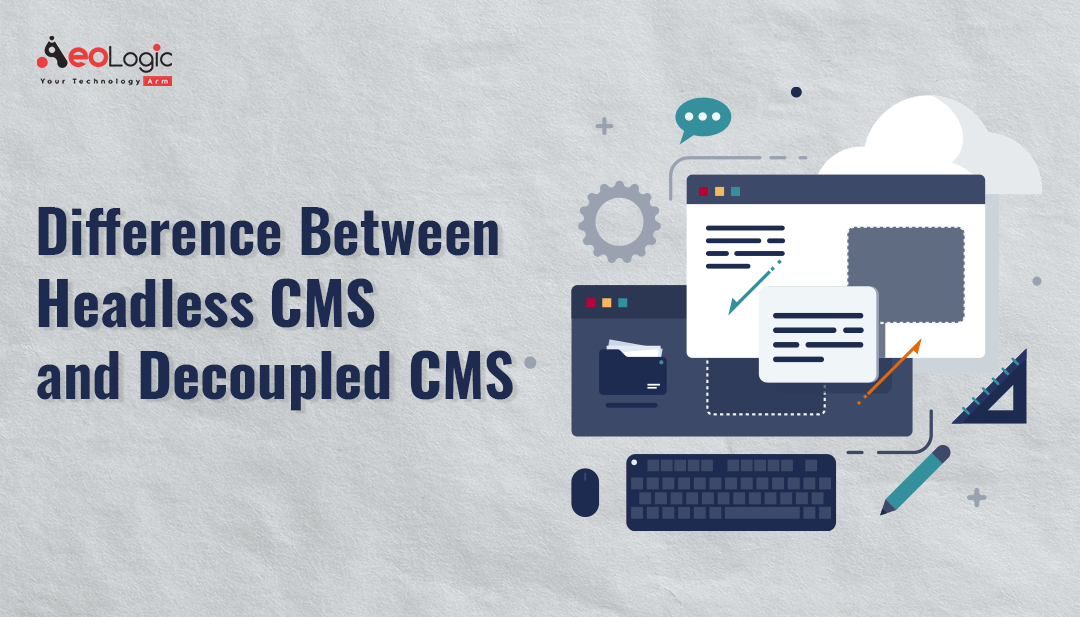Unlike conventional Web CMS, decoupled or headless CMSs are using a separate infrastructure for authoring and delivery. However, there are a few key difference between headless CMS and decoupled CMS to consider.
Decoupled CMS, headless CMS, traditional CMS, legacy CMS – all terms are used when teams are looking for a new system to store their growing content needs. However, it isn’t always certain what the differences between them are. In this post, let’s take a look into the difference between headless CMS and decoupled CMS.
Also read: Digital Transformation Examples for Business Success
What is a Decoupled CMS?
A decoupled CMS is a content management system that is having a separate frontend and backend. However, it is usually having an included frontend presentation layer.
The presentation layer helps in enabling teams to have the benefits of separate frontend and backend systems while still having a way to get up and running rapidly. Decoupled CMS often include pre-configurations and templates which is making it easy for teams to get up and running with their digital experiences. In a way, Decoupled CMS is similar to traditional CMS or page-builders, where teams may want to have a preview mode that is directly presented to them based on their changes in the CMS.
Disadvantages of a Decoupled CMS
The major drawback of decoupled CMS is that they make assumptions about your frontend. Instead of being able to flexibly construct for any type of presentation layer, whether that be a IOT device, website, or application, teams are limited to the preconfigured templates for a particular frontend. While you may choose not to incorporate the frontend templates when creating sites, you lose the value of a decoupled CMS giving you a ready-to-go frontend.
Another difference between headless CMS and decoupled CMS is- while usually more customizable than Web CMS, Decoupled CMS is less flexible than headless CMS and can become cumbersome with time.
Advantages of a Decoupled CMS
The major benefits of decoupled CMS are that they make it easier for teams with limited frontend resources to get up and running fast. Yet, they attain the benefits of a traditional CMS. Some Headless CMS can offer teams a similar experience to a decoupled CMS with integrations. Let’s consider the Pros and Cons of Decoupled CMS: Pros and Cons.
Pros:
- Teams are having a presentation layer out of the box for simple use cases
- Furthermore, teams having limited resources can get up and running rapidly
- Teams that are familiar with the page builder approach will be finding the experience similar
Cons:
- Teams having to build frontend for custom, more complex use cases where the existing template may become a deadweight
- It is less flexible than headless CMS
- Here, templates tend to become limiting over time
Also read: Comparison Between ChatGPT and Google AI Application
What is a Headless CMS?
On the other hand, a headless CMS is a content management system that is only focusing on delivering content via API, usually in a structured JSON format. A headless CMS is providing no built-in presentation layer and it does not provide any themes or templates out of the box. Hence, making it a highly flexible system. That too, without the restrictions of a template-based CMS.
Headless CMS is allowing teams to build a flexible, data-rich content repository that can be incorporated for a wide range of use cases – from highly complex streaming platforms to marketing websites focused on SEO and modern eCommerce solutions.
Thereby, considering the structured content approach is helping in future proof their tech stacks and making it easy to take advantage of UX innovations of evolving frontend frameworks.
Disadvantages of a Headless CMS
There are several difference between headless CMS and decoupled CMS. However, there are a few disadvantages of a headless CMS. Drawbacks of a headless CMS include the importance of developer resources, and that the initial setup may require planning across the tech stack. Resources and a quick start guide about what to consider when getting started with a microservice tech stack can be helpful resources to facilitate bridging the information gap in the early days of working with a headless CMS.
Advantages of a Headless CMS
The advantages of a headless CMS include more agility, greater flexibility, and improved performance. Teams can operate independently of each other while building a powerful end product. With a headless CMS, the final customized tech stack will be meeting the requirements of a team’s use case.
Let us consider the pros and cons of headless CMS.
Pros:
- Headless CMS is having the ability to build products for multiple channels whereas drawing from a single data-rich content repository
- It is having a flexible system that is enabling greater customization
- Agile team workflows make sure that teams are working efficiently
- Expedite new project deadline
Cons:
- One major disadvantage of headless CMS is that in building the initial infrastructure, it may take time for a few teams new to the headless approach
- Whereas, requiring onboarding for teams to adjust to the lack of a presentation layer or teams may build a presentation layer using integrations
Also read: 10 Technologies Leading Digital Transformation In Retail
Final thoughts
There are several difference between headless CMS and decoupled CMS. I hope this article has explained the major differences, advantages, and disadvantages of headless CMS and decoupled CMS.
To evaluate which system is more beneficial to your use case, connect with us to learn more about the applications of a headless CMS and decoupled CMS in the real world.
FAQs
Is headless the same as decoupled?
Headless architecture is a subset of decoupled infrastructure. Both are having content management and storage back ends. And it delivers content from that database through a web service or application programming interface API.
What is the difference between CMS and headless CMS?
While traditional CMS aims to be a single solution for managing both the content and the front-end. On the other hand, a headless CMS deals only with the content. Whereas, the headless CMS has no impact or input on the front-end.





